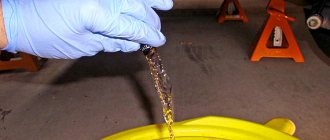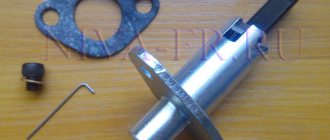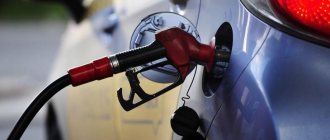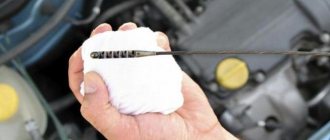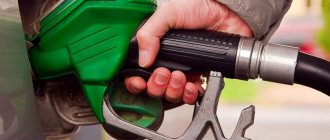Hello, our dear friends! Tell me, do you constantly use the same type of fuel with the same octane number? Did you have to change it periodically, experimenting with the characteristics of the engine or simply in the hope that it would consume less fuel? Surely this is so, I know from myself. In this regard, let's look at the question: is it possible to mix 92 and 95 gasoline and is there any benefit or harm from this...
The process of obtaining gasoline from oil
Various types of gasoline are obtained by distilling oil. There are several types of petroleum processing. Distilling oil into gasoline is a series of chemical temperature processes.
Direct distillation of raw materials produces straight-run gasoline. To improve the quality of the resulting gasoline, it is recycled.
The following recycling methods are used:
- catalytic reforming;
- hydrocracking;
- catalytic cracking;
- thermal cracking and some others.
Using direct distillation - rectification - gasoline was produced at the dawn of the automobile industry. Using this method, crude oil is heated, and as its temperature rises, the crude oil is separated into different fractions that differ in boiling point.
Rectification can be carried out both at atmospheric pressure and in vacuum of different depths. The resulting gasoline has low octane levels, not higher than 60 units.
To obtain higher quality fuel suitable for use in modern carburetor and injection internal combustion engines, other methods are used. The most common among them are catalytic and thermal cracking.
The basis of the cracking process is the decomposition of oil components into fractions by heating to high temperatures using catalysts. During the cracking process, complex hydrocarbon compounds are decomposed into simple ones, which have a lower molecular weight.
The advantages of cracking are:
- increased productivity of the process, gasoline yield increases by 40-50%;
- improving the quality of the resulting fuel - detonation resistance can range from 70 to 90 units;
- To obtain a commercial petroleum product from gasoline obtained by cracking, a smaller amount of additives is required.
When producing fuel, additional technologies can be used in production lines to improve the quality of the final product and increase the depth of processing of petroleum feedstock.
What is octane number?
The main characteristic of fuel for gasoline internal combustion engines is the octane number. This value indicates the degree of resistance of the fuel intended for a carburetor engine to spontaneous detonation.
The most common gasolines are compositions with knock resistance equal to 92, 95 and 98 units.
To improve the quality of fuel and increase its resistance to spontaneous detonation, various additives are used.
Such complexes include:
- alkyls;
- esters;
- alcohols;
- additives that increase the resistance of fuel to freezing.
When determining the detonation resistance of fuels, isooctane and n-heptane are used as standards. The detonation resistance of the first compound is taken to be 100 units, and for the second substance it is 0 units. N-heptane is capable of self-detonation under natural conditions.
A mixture of these compounds in different percentages represents the value of resistance to detonation, expressed in units.
To determine the value of detonation resistance, the research and motor method is used.
Gasoline class
The current GOST establishes the following grades of fuel for gasoline internal combustion engines:
- AI-80.
- AI-92.
- AI-95.
- AI-98.
For each brand of fuel there are 4 environmental classes:
- K2 (up to 500 mg of sulfur per 1 kg, and the share of monomethylamine is not more than 1.3%);
- K3 (up to 150 mg/kg and 1% MMA);
- K4 (up to 50 mg/kg and 1% MMA);
- K5 (up to 10 mg/kg and complete absence of MMA).
The value of detonation resistance is not related to the class of environmental cleanliness.
In addition to the indicated environmental safety rating, fuel for gasoline internal combustion engines is divided into classes depending on volatility.
In accordance with GOST, gasoline is divided into the following classes:
- A, B - summer;
- C, D, E, F - winter;
- C1, D1, E1, F1 - off-season.
In total, there are 10 classes of fuel depending on volatility.
Types of additives
A fuel additive is a drug added to fuel to improve its performance.
There are 4 types of gasoline additives:
- dehumidifiers;
- cleaners;
- octane correctors;
- A separate type of additives with combined properties has been developed.
Water neutralizers, or dryers, are designed to remove small amounts of moisture from fuel, which can freeze in winter.
Injector cleaners ensure cleaning of injectors and power unit valves from deposits and carbon deposits without disassembling the engine. This additive works well with low mileage.
Octane correctors provide an increase in the octane number in the fuel, which helps reduce fuel consumption and increase vehicle power.
Such additives may consist of:
- monohydric alcohols;
- esters;
- allotropes of carbon.
One of the most common additives is FuelEXx Gasoline. This mixture, when added to the fuel, allows the combustion chamber to be cleaned of accumulated soot and varnish deposits, which improves the functioning of the power unit.
Another additive used by car owners is CeraTec, manufactured by Liqui Moly. The basis of the product is liquid ceramics. The use of the composition increases engine power, reduces fuel consumption and improves the operating mode of the power unit.
How both types of fuel are produced
Probably the most important thing why such a question comes to mind is related to saving on the costs of fuels and lubricants. It worries drivers who have to travel tens, or even hundreds of kilometers every day. The octane number can be different: 76, 92, 95, 98 and so on. Someone used to traditionally fill in the 95th, which costs more and hopes to spend less. Another owner, after ’92, heard that if you switch the car to higher octane fuel, the consumption will decrease, but its combustion in the cylinders will improve.
Another way to find a universal answer to this dilemma is to try to mix both types of fuel in order to universalize their best properties. Based on the 92nd type of fuel, grades of gasoline with a higher octane number are also produced today. This is the simplest way to increase octane, which involves adding various technological additives. That is, few manufacturers purchase the corresponding petroleum raw materials, when it is much easier to raise the cost of it using the same additives. This is why many drivers prefer to refuel with pure 92-grade gasoline, citing the fact that it does not contain any additives, but only pure fuel obtained from the chemical distillation of oil.
Risks and consequences when mixing gasoline
When refueling a car with 95 fuel, if there is already 92 gasoline, you should remember that the fuel in the tank will practically not mix. This occurs due to the fact that different fuels have different densities.
If you fill the tank with fuel with an octane number of 95 and 92, they will separate and the 95 fuel, being lighter, will collect on the surface of the 92. When the engine is running, first one type of fuel will be produced, and then a second, the benefit will be in improving the quality of the fuel mixture in in this case is doubtful. But if the car’s engine is designed for operation using AI-92, filling the tank with AI-95 will not cause the power unit to fail.
What happens to a car if you mix gasoline with different octane numbers?
In order to understand the consequences of mixing different types of gasoline in a gas tank, you should understand the logic of fuel production in modern factories. All gasoline in our country is produced today by cracking, which can be thermal (high-temperature processing of hydrocarbons without air access) and catalytic (when heated, various catalysts are used - metals, their oxides, various salts).
The maximum octane number (ON) that gasoline can have after cracking is 80. Then, special additives are used to improve the quality of the final product. Today these are, as a rule, compositions with alkyls, ethers, alcohols, and additives that increase the resistance of fuel to freezing. With their help, it is possible to bring the score to: 92, 95, 98 and even 100.
In other words, all gasolines have the same base, and the differences lie in the different quality and quantity of additives. At the same time, harmful additives such as tetraethyl lead are prohibited by law today. Although, according to media reports, banned tetraethyl lead, which is purchased in China and Romania, still continues to be illegally imported into Russia. To avoid running into such fuel, there is only one piece of advice - use proven, network gas stations.
Thus, the answer to the question of what will happen if you mix fuel with different octane numbers will be as follows - absolutely nothing. The resulting mixture will have a single base, and the maximum that such a mixture can cause is a loss of the dynamics of your car.
But what about the danger of mixing fuel from gas stations of different companies? There is no need to be afraid of such a mixture either. Although different manufacturers, as is known, “chemically” use additives in an effort to provide their branded fuel with optimal characteristics, such additives are de facto a drop in the ocean. Fuel at Russian gas stations is standardized, meaning the differences are minimal.
At the same time, those who like to splash “ninety-five” into the gas tank and add it to “ninety-two” should understand that the fuel in the tank will practically not mix. This happens primarily because different fuels have different densities.
As a result, AI-95, as a lighter fuel, will be collected, relatively speaking, on the surface of the 92nd. So first one, more efficient type of fuel will be produced, and then a second one. Subjectively, at first it may seem that “the car is moving” - the throttle response will increase. However, this effect will soon be minimized. The actual gain in improving the quality of the fuel mixture will be doubtful.
It’s a different story when, to save money or for other reasons, they pour 92-grade gasoline with a tolerance of “not lower than 95.” We have already explained above what can happen in this case. At first - the first kilometers - everything will be fine, but when the top layer - the 95th - burns out, the remaining 92nd will begin to cause harm to the power unit. This practice is fraught with detonation, which can cause failure of parts of the cylinder-piston group. If problems arise with the engine, servicemen, of course, will take fuel samples from the tank, and then do not count on warranty repairs.
What happens if you pour 92 gasoline into an engine designed to use 95?
If the power unit is designed for operation only on AI-95, then filling it with low-octane fuel can have a significant impact on the operation of the internal combustion engine.
A higher octane number implies a lower combustion temperature of the fuel mixture. Changing this parameter when using low-octane fuel affects the technical characteristics of the engine.
When the engine runs on such gasoline, the combustion temperature of the mixture can increase to a level not provided for by the design, which provokes accelerated wear, burnout, or melting of the structural elements of the cylinder-piston group.
The use of low-octane fuel in an engine designed to use 95 octane fuel leads not only to accelerated wear, but also to increased fuel consumption.
Mixing 92 and 95 gasoline in the tank
Based on the technological process for producing gasoline, it turns out that 92 is cleaner, since it contains fewer additives. Because of this, many motorists prefer to refuel exclusively with AI-92. However, the vast majority of drivers often mix two types of fuel, believing that this way they successfully combine the low cost and improved characteristics of gasoline. In fact, different gasolines differ not only in their detonation resistance, but also in their density. AI-92 is characterized by a higher density and is heavier. 95 gasoline is much lighter due to its lower density. Due to these characteristics, when mixing two types of fuel, 92 will settle to the bottom of the gas tank, and 95 will appear on the surface. It turns out that there is no actual mixing of fuel in the tank. Fuel will be consumed in turn, which means it will not be possible to improve engine performance by mixing two types of gasoline. The only plus in this is a small saving due to the different costs of AI-92 and AI-95. The savings in this case will be expressed in several rubles, but for some car enthusiasts this is a compelling argument for mixing two types of fuel.
Similar Mazda CX-5
Differences
But first, let's talk in a nutshell about the differences between these two most popular brands offered at gas stations.
After all, many drivers, especially beginners, think that the 95 is of higher quality compared to the 92 and cannot harm the engine. But the opposite is true. Higher gasolines are made on the basis of 92
, by adding all sorts of additives to it that can increase the octane number. Therefore, 92 is cleaner than its counterparts, it turns out (although, according to experts, in the Russian expanses, especially in the outback, it is difficult to find fuel that is not created with the help of additives, even 92). But the same experts claim that due to the low octane, 92 and there are few additives, and it itself is cleaner.
By the way, adding these chemicals and bringing raw materials to rank 95 costs gas stations less than purchasing the same material from oil refineries. That's why so many people are doing body blows. Such a homemade 95 can be extremely dangerous for the engine, since the buyer does not know for certain what has been added to it!

